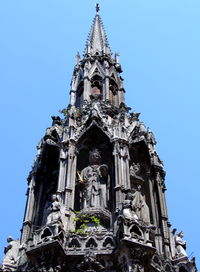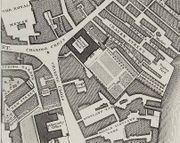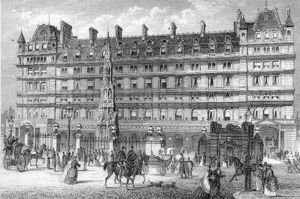Charing Cross
| Charing Cross | |
 The Victorian replacement of the original Eleanor Cross; from which the area derives its name. |
|
 Charing Cross
|
|
| OS grid reference | |
|---|---|
| London borough | Westminster |
| Ceremonial county | Greater London |
| Region | London |
| Country | England |
| Sovereign state | United Kingdom |
| Post town | LONDON |
| Postcode district | WC2 |
| Dialling code | 020 |
| Police | Metropolitan |
| Fire | London |
| Ambulance | London |
| EU Parliament | London |
| UK Parliament | Cities of London and Westminster |
| London Assembly | West Central |
| List of places: UK • England • London | |
Charing Cross denotes the junction of the Strand, Whitehall and Cockspur Street, just south of Trafalgar Square in Westminster within Central London, England. It is named after the site of a long demolished Eleanor cross (now occupied by a statue of King Charles I mounted on a horse) located at the former hamlet of Charing, at this point. Since the second half of the eighteenth century Charing Cross has been seen as the centre of London. It is the primary of the central datum points for measuring distances from London along with the London Stone and the doors of St Mary-le-Bow church.
Contents |
History
Location and etymology
"Erect a rich and stately carved cross, Whereon her statue shall with glory shine; And henceforth see you call it Charing Cross." George Peele The Famous Chronicle of King Edward the First (1593)
The name originates from the Eleanor cross erected in 1291-4 by King Edward I as a memorial to his wife, Eleanor of Castile, and placed between the former hamlet of Charing and the entrance to the Royal Mews of the Palace of Whitehall. The cross was the work of the medieval sculptor, Alexander of Abingdon.[1] Originally built in wood, it was replaced with a stone and marble monument.[2] The name of the hamlet of Charing is derived from the old English word "cierring", referring to the nearby bend in the River Thames.[3][4]
Since 1675 the site of the cross has been occupied by a statue of King Charles I mounted on a horse. That original position of the cross is recognised by modern convention as the centre of London for the purpose of indicating distances by road in favour of other previous measurement points (such as St Paul's Cathedral which remains as the root of the English and Welsh part of the Great Britain road numbering scheme). Furthermore, all residential roads in Greater London have the houses numbered such that number 1 is at the end closer to Charing Cross as the crow flies. Charing Cross is marked on contemporary maps as a road junction, though it was previously also a postal address denoting the stretch of road between Great Scotland Yard and Trafalgar Square. Since 1 January 1931 this section of road has been designated as part of the Whitehall thoroughfare.[5]
The Cross has given its name to a railway station, a hotel, a hospital - founded locally, a police station; and two places of entertainment, the Charing Cross Theatre and the Charing Cross Music Hall (which lay beneath the arches of the station). Charing Cross Road the main route from the north (which becomes the east side of Trafalgar Square) was named for the railway station which was a major destination for traffic, rather than for the original cross.[6]
St Mary Rounceval

Between 1232–36, the Chapel and Hospital of St Mary Rounceval was founded at Charing. This occupied land at the corner of the modern Whitehall and into the centre of Northumberland Avenue, running down to a wharf by the river. This was an Augustinian house, tied to a mother house at Roncesvalles, in the Pyrenees. The house and lands were seized for the King in 1379, under a statute "for the forfeiture of the lands of schismatic aliens". Protracted legal action returned some rights to the Prior, but in 1414, Henry V finally suppressed the 'alien' houses. The priory fell into a long decline due to lack of money, with further arguments over the collection of tithes with the parish church of St Martin-in-the-Fields. In 1541, religious artefacts were removed to St Margaret's, and the chapel was adapted as a private house, with the almshouse being sequestered to the Royal Palace.[7]
In 1608–09, the Earl of Northampton built Northumberland House on the eastern portion of the property. The house suffered some damage in the Wilkes' Election Riots of 1768, the Duke saved his property by the expedient of opening the nearby Ship Ale House, which drew off the rioters. In June 1874, the whole of the Duke's property at Charing Cross, was purchased by the Metropolitan Board of Works for the formation of Northumberland Avenue.[8]
The frontage of the Rounceval property caused the narrowing at the end of the Whitehall entry to Charing Cross, and formed the section of Whitehall formerly known as Charing Cross, until road widening in the 1930s caused the rebuilding of the south side of the street – creating the current wide thoroughfare.[7]
Battle
In 1554, Charing Cross was the locus of the final battle of Wyatt's Rebellion. This was an attempt by Thomas Wyatt, with others, to overthrow Queen Mary I of England, soon after her accession to the throne; and replace her with Lady Jane Grey. Wyatt's army had come from Kent, and with London Bridge barred to them, had come via the then next Thames bridge at Hampton Court. Their circuitous route brought them down St. Martin's Lane to Whitehall.[2]
The palace was defended by 1,000 men under Sir John Gage at Charing Cross; they retreated within Whitehall after firing their shot, causing consternation within — thinking the force had changed sides. The rebels – themselves, fearful of artillery on the higher ground around St James's – did not press their attack and marched onto Ludgate; where they were met by the Tower Garrison and surrendered.[2]
Civil war removal
The Eleanor Cross was pulled down, by order of Parliament, in 1647, at the time of the English Civil War, becoming the subject of a popular Royalist ballad:
- Methinks the common-council shou'd
- Of it have taken pity,
- 'Cause, good old cross, it always stood
- So firmly in the city.
- Since crosses you so much disdain,
- Faith, if I were you,
- For fear the King should rule again,
- I'd pull down Tiburn too. (extract from "The Downfall of Charing Cross"[9])
At the Restoration eight of the regicides were executed here, including the notable Fifth Monarchist, Colonel Thomas Harrison.[10] A statue of Charles I, was later erected on the site. This statue had been made in 1633 by Hubert Le Sueur, in the reign of Charles I, but, in 1649, was ordered to be destroyed by Parliament. Subsequently, after being hidden by the man charged with destroying the statue, it resurfaced at the Restoration; and was erected here in 1675.[11]

A prominent pillory, where malefactors were publicly flogged, was situated next to the statue of King Charles.[13] To the south of Charing Cross was the Hungerford Market, established at the end of the 16th century; and to the north was the King's Mews, a royal stable. The area around the pillory was a popular place of street entertainment. Samuel Pepys records in his diaries visiting the surrounding taverns and watching the entertainments and executions that were held there.[14] This whole area was transformed when Trafalgar Square was built on the site in 1832.
A famous inn called the "Golden Cross" - first mentioned in 1643 - was situated in the former village of Charing. From here, in the eighteenth and nineteenth centuries, coaches departed by various routes to Dover, Brighton, Bath, Bristol, Cambridge, Holyhead and York. The inn features in Sketches by Boz, David Copperfield and The Pickwick Papers by Charles Dickens. In the latter, the dangers to public safety of the low archway between the inn to the street were pointed out by Mr Jingle in a somewhat memorable fashion:
"Heads, heads - take care of your heads", cried the loquacious stranger as they came out under the low archway which in those days formed the entrance to the coachyard. "Terrible place - dangerous work - other day - five children - mother - tall lady, eating sandwiches - forgot the arch - crash - knock - children look round - mother's head off - sandwich in her hand - no mouth to put it in - head of family off"
The inn was demolished for the creation of Trafalgar Square and a new Golden Cross Hotel was built in the 1830s on the triangular site now fronted by South Africa House. Though this hotel is now also gone, the memory is preserved in commercial offices facing the Strand named Golden Cross House.
Replacement

The railway station opened in 1864, fronted on the Strand with the Charing Cross Hotel. In 1865, a replacement cross was commissioned from E. M. Barry by the South Eastern Railway as the centrepiece of the forecourt of the hotel; about 160 feet (49 m) east of the original site. It is not a replica, being of an ornate Victorian Gothic design based on George Gilbert Scott's Oxford Martyrs' Memorial (1838). The Cross rises 70 feet (21 m) in three main stages on an octagonal plan, surmounted by a spire and cross. The shields in the panels of the first stage are copied from the Eleanor Crosses and bear the arms of England, Castile, Leon and Ponthieu; above the 2nd parapet are 8 statues of Queen Eleanor. The Cross was designated a Grade II* monument on 5 February 1970.[15] The month before, the bronze equestrian statue of Charles, on a pedestal of carved Portland stone was given Grade I listed protection.[16]
Fragments of the medieval original remain in the Museum of London.
Official use as central point
Since the second half of the eighteenth century Charing Cross has been seen as the centre of London.[17] From the early 19th century, legislation that was applicable only to the London metropolis used Charing Cross as a central point to define its geographical scope. Its later use in legislation waned in favour of providing a schedule of local government areas and became mostly obsolete with the official creation of Greater London in 1965.
| Use | Scope |
|---|---|
| Metropolitan Police District | The Metropolitan Police Act 1829 made provision that all parishes within 12 miles could be added. This was expanded to 15 miles by the Metropolitan Police Act 1839. |
| Metropolitan Buildings Office | The London Building Act 1844 allowed that any place within 12 miles could be added to the area of responsibility. |
| Hackney carriage licensing & The Knowledge | The London Hackney Carriage Act 1831 and subsequent legislation set the radius within which cab drivers were obliged to take a fare. Streets within a six-mile radius of Charing Cross are still included in taxi driver training. |
| Street Trading | The Metropolitan Streets Act 1856 gave the Commissioner of Metropolitan Police the power to control various activities within a six mile radius of Charing Cross. Powers to licence shoeblack pitches are still in force but in practice are superseded by individual London boroughs' street trading arrangements. |
Transport and locale
 |
Trafalgar Square | Covent Garden | Kingsway |  |
| The Mall | Strand | |||
| Whitehall | London Waterloo via Golden Jubilee Bridges |
South Bank via Waterloo Bridge |

- Nearest stations
To the east of the Charing Cross road junction is Charing Cross railway station situated on the Strand. On the other side of the river, connected by the pedestrian Golden Jubilee Bridges are Waterloo East station and Waterloo station.
The nearest London Underground stations are Charing Cross and Embankment.
External links
References
- ↑ Medieval and Renaissance: Past, Present and Future: Charing Cross Stuart Frost (Victoria and Albert Museum) accessed 13 February 2009
- ↑ 2.0 2.1 2.2 Charing Cross, the railway stations, and Old Hungerford Market, Old and New London: Volume 3 (1878), pp. 123-134. accessed: 13 February 2009
- ↑ "Charing Cross -- Britannica Online Encyclopedia". library.eb.co.uk. http://library.eb.co.uk/eb/article-9022531?query=charing%20cross&ct=. Retrieved 2010-07-07.
- ↑ Helen Bebbington London Street Names (1972) –
- ↑ Harold P. Clunn (1970) The Face of London: 254
- ↑ Shaftesbury Avenue and Charing Cross Road, Survey of London: volumes 33 and 34: St Anne Soho (1966), pp. 296-312. Date accessed: 3 March 2009
- ↑ 7.0 7.1 The chapel and hospital of St. Mary Rounceval, Survey of London: volume 18: St Martin-in-the-Fields II: The Strand (1937), pp. 1-9. Date accessed: 14 February 2009
- ↑ Northumberland House, Survey of London: volume 18: St Martin-in-the-Fields II: The Strand (1937), pp. 10-20. Date accessed: 14 February 2009
- ↑ Alan Brooke and David Brandon (2004). Tyburn: London's Fatal Tree. Stroud, Sutton: 238
- ↑ Ben Weinreb and Christopher Hibbert (1983) The London Encyclopaedia: 138
- ↑ Ben Weinreb and Christopher Hibbert (1983) The London Encyclopaedia: 815
- ↑ A print drawn by Augustus Pugin and Thomas Rowlandson for Rudolph Ackermann's Microcosm of London (1808-11).
- ↑ Arthur Groom (1928) Old London Coaching Inns and Their Successors: 3
- ↑ Pepys Diary - frequent visits between 1660–69. Particularly 13 October 1660 – for his account of the execution of Harrison.
- ↑ Images of England — details from listed building database (427795) accessed 13 February 2009
- ↑ Images of England — details from listed building database (209087) accessed 13 February 2009
- ↑ "The spirit of despotism: invasions ... - Google Books". books.google.co.uk. http://books.google.co.uk/books?id=K6qxPXnzLR8C&pg=PA34&dq=centre+of+London+charing+cross&hl=en&ei=p0c0TLySD4GRjAfgkMyWBg&sa=X&oi=book_result&ct=result&resnum=8&ved=0CFQQ6AEwBw#v=onepage&q=centre%20of%20London%20charing%20cross&f=false. Retrieved 2010-07-07.
|
|||||||||||||||||||
|
||||||||
